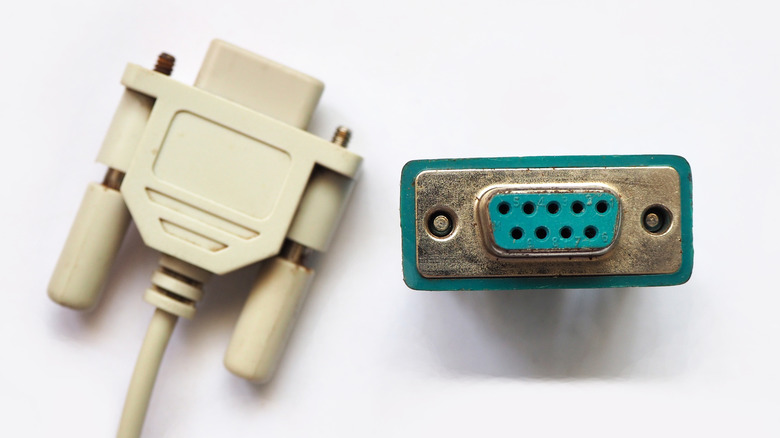Here's What A Computer's Serial Port Was For (And Where It's Still Necessary)
If you've been using computers for more than a couple of decades, you've probably used a serial port to attach peripherals like your mouse and modem. Until the USB standard rendered them obsolete in the late 1990s, serial ports were a standard feature. Also known as a COM or RS-232 port, a serial port is a rectangular connector with small pinholes arranged in rows, often surrounded by a metal casing with screws on either side to secure the connection. They were invented in the 1960s and were the first universal, standardized way to connect devices.
The "serial" part of the serial port's name describes how data is transmitted one bit at a time in a single line or "series." There were also parallel ports on computers that sent multiple bits (usually an entire byte) simultaneously over multiple wires. Parallel ports were longer and often used to connect printers. They were frequently simply referred to as printer ports. Both serial and parallel ports were slow by modern standards, and by the 2000s, they had largely disappeared from home computers, which now use faster USB ports for almost everything.
Serial Ports are still used today
However, consumer tech isn't the only game in town. While you won't find a serial port on a modern laptop, they're still found in commercial equipment. For example, you can use a serial port to link a heart monitor to a treadmill, or a cash register with a barcode scanner. Industrial sensors and actuators also frequently use serial ports to connect to other devices. In all these environments, serial ports have many advantages over USB. Serial ports are physically robust, cheaper, and work well for devices that don't need high-speed data transfer. A treadmill sending small bits of information to a heart monitor doesn't require lightning-fast speeds. The technology is reliable and predictable, and this gives serial ports their main advantage: stability.
Serial communication has remained largely unchanged for decades, meaning devices designed many years ago can still operate today using the same simple connection. Serial ports offer a level of consistency that's critical in industries where downtime isn't an option, which is why hospitals, factories, and transportation systems continue to use them for essential operations. And if you do need to connect equipment with a serial port to a modern computer, you can do so by using a USB-to-serial adapter. While it's unlikely that we'll ever see a serial port making a comeback on consumer laptops or smartphones, the tech isn't going away anytime soon.

